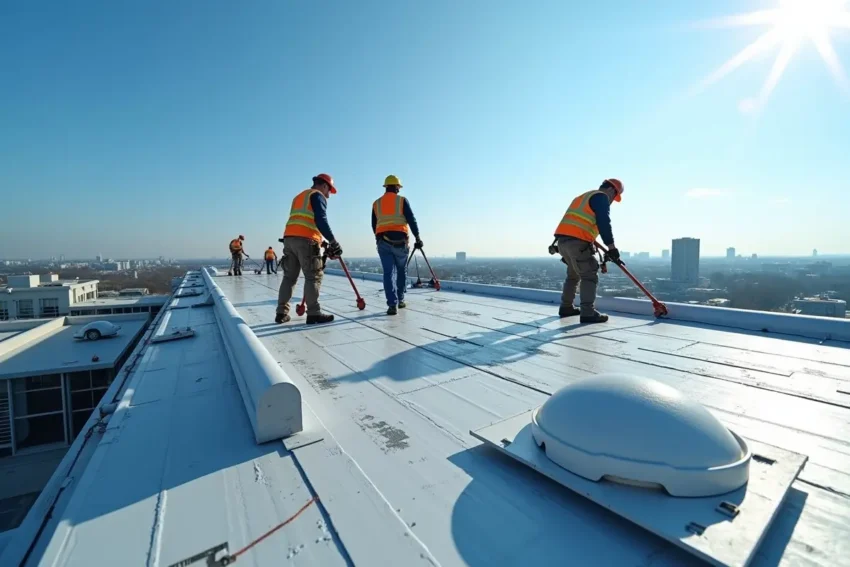In the evolving world of commercial roofing, staying current with industry advancements is vital for building owners and property managers who want to protect their investment and enhance performance. From sustainable technologies to state-of-the-art materials, today’s trends are shaping not only the longevity of commercial structures but also their bottom line. Businesses seeking expert services for commercial roof repair South Florida can particularly benefit from understanding these cutting-edge solutions and how they address specific climate challenges.
Upgrading roofing offers benefits like reduced energy use, lower maintenance costs, and meeting sustainability goals. With stricter regulations and rising energy prices, modern roofing has become essential for new or existing buildings, adding value and improving safety, sustainability, and efficiency. Innovations like smart sensors and eco-friendly materials are now common in projects of all sizes, enhancing protection, performance, and savings.
Sustainable Roofing Materials
The demand for environmentally responsible roofing solutions continues to climb as businesses strive to meet sustainability objectives and reduce operational costs. Materials such as recycled metal, rubber, and plastic divert tons of waste from landfills while also providing superior resilience against sun, rain, and wind.
Green roofs featuring vegetation layers are particularly attractive in urban areas—they help insulate the building, manage stormwater runoff, provide habitats for wildlife, and even improve air quality. According to the U.S. Environmental Protection Agency, green roofs can decrease cooling costs significantly during hot months.
Integration of Solar Technology
As energy costs grow, more commercial buildings are equipped with solar-integrated roofing. Systems like flexible solar membranes or solar shingles enable property owners to generate renewable electricity while preserving the building’s aesthetic appearance.
This technology is especially valuable in sun-rich regions, turning passive roof space into a productive asset. Solar roofs can help businesses achieve LEED certification and other environmental benchmarks, while also generating power to reduce their reliance on the grid.
Smart Roofing Systems
Recent advances in smart roofing harness sensors, drones, and artificial intelligence to enhance roof management. These technologies enable real-time monitoring and maintenance. Drones scan large roof areas and, paired with thermal cameras, quickly identify leaks, insulation gaps, and surface deterioration that might otherwise go unnoticed.
Meanwhile, AI-driven predictive maintenance programs forecast maintenance needs and schedule interventions before small issues turn into significant problems, saving time and resources in the long run.
Advanced Roofing Coatings
Modern coatings are revolutionizing the protection and maintenance of commercial roofs. Reflective coatings reduce the roof’s temperature by bouncing sunlight away, which lessens the burden on HVAC systems and contributes to lower utility bills. Nanotechnology has also paved the way for self-healing membranes that automatically seal tiny punctures or cracks, extending the lifespan of the roof under demanding commercial conditions.
Modular and Prefabricated Roofing
Prefabrication is revolutionizing commercial roofing by allowing large components to be manufactured off-site to precise specifications. These ready-to-install systems reduce construction waste, accelerate project timelines, and ensure consistent quality. Modular roofing is particularly useful for big developments where speed and cost control are top priorities. This approach is also less disruptive to ongoing business operations compared to traditional construction methods.
Impact-Resistant Roofing
Frequent severe weather underscores the importance of using impact-resistant roofing. Materials like modified bitumen or enhanced synthetic membranes provide exceptional resistance to hail, wind-blown debris, and heavy rain. Such products maintain their integrity even during the harshest storms, preserving the safety and productivity of a commercial space.
Enhanced Maintenance Practices
Proactive roof maintenance is simpler and more effective thanks to tools like drones and infrared imaging. By spotting leaks or weak points early, businesses can avoid major repairs and extend the operational life of their roofs. Up-to-date maintenance not only prevents downtime but also ensures compliance with warranty and insurance requirements, adding peace of mind for business owners.
Fire-Resistant Roofing Solutions
Modern fire regulations require commercial roofs to provide robust fire protection. Solutions featuring materials certified with UL Class A fire ratings deliver top-of-the-line resistance against fire spread while also providing optimal insulation. These choices are especially important for buildings in dense city centers or areas prone to wildfires, as they meet local codes and safeguard assets.
Embracing these trends ensures that commercial buildings remain cost-efficient, sustainable, and resilient in the face of modern challenges. By leveraging the latest commercial roofing technology, businesses can secure their premises while meeting both operational and sustainability goals.
Conclusion
Modern trends in commercial roofing solutions highlight the industry’s shift toward innovation, sustainability, and efficiency. From energy-saving materials and eco-friendly installations to advanced technologies that enhance durability and performance, today’s roofing options go beyond basic protection—they actively add value to businesses.
By embracing these forward-looking approaches, property owners can reduce costs, extend the lifespan of their roofs, and create safer, more sustainable buildings. Staying informed about these evolving solutions ensures companies make smart investments that support both long-term functionality and environmental responsibility.

